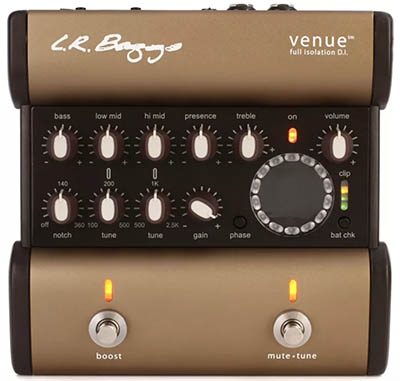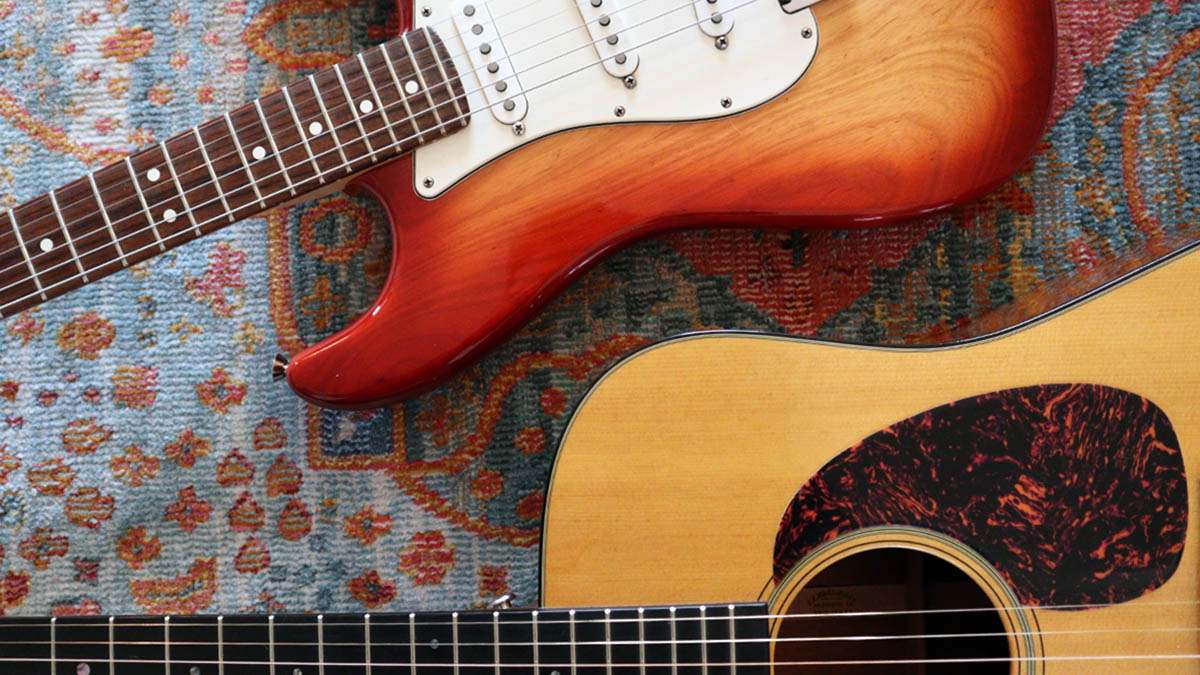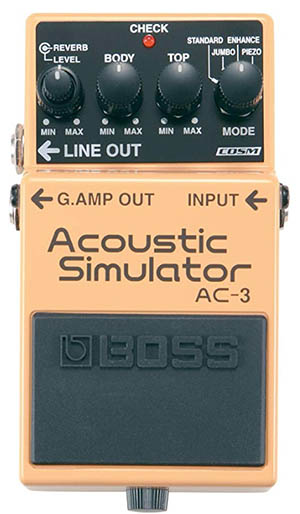While some players are looking for reasons why their electric guitar is sounding too much like an acoustic guitar, others are looking for ways to emulate the clean crisp brightness of the acoustic guitar. The best way to achieve this is through the use of an acoustic simulator effects pedal. In this article we’ll also look at some other ways to get that acoustic sound out of your electric guitar.
Table of Contents
Get An Acoustic Simulator
A clean electric guitar sound and an acoustic guitar sound are not the same thing. While a clean electric tone (which we’ll address in a second) gets our electric close, there’s still something about an acoustic guitar which provides a unique sound.
An acoustic guitar sounds woody, clear, and elemental. The brightness of a phosphor bronze guitar string combined with the natural wood grain produces a musical tone that just doesn’t occur in electric guitars. While electric guitars are themselves full of wood, the pickup is transferring string motion into an electromotive force which is output to the amp. Fundamentally speaking, the acoustic and electric guitars amplify sound in entirely different ways.
If you’re looking to get an acoustic sound from your electric guitar, you need to pick up an acoustic simulator. The most common is the Boss TU-3 Acoustic Simulator. This is the classic tried and true pedal which will turn your electric guitar into that bright, woody instrument that we’re trying to emulate.
The AC-3 above is the pedal only, consider getting the bundle with power cord and patch cables if you don’t already have those.
One of the great features of the Boss AC-3 is the line out option. In the standard configuration this pedal would sit with other effects pedals and the output would then run into your electric guitar amp. This works great, and allows an electric guitar and electric guitar amp to double as an acoustic rig with the guitar and acoustic amp without all the hassle.
With the line out however, you can also send your acoustic simulator output directly past you electric amp and out through a line level directly to the sound board. This eliminates the electric voicing of the guitar amp and allows for a sound guy (or you if it’s a small gig) to voice the output of the acoustic pedal to the PA perfectly.
The AC-3 along with many tone shaping options also gives you some reverb. An acoustic guitar has a natural reverb because of the cavern effect the body of the guitar creates. As sound bounces around inside the guitar, it generates a very slight echo which sounds to us like a subtle reverb. This reverb is one of the characteristics of an acoustic guitar which the AC-3 emulates spectacularly.
The AC-3 includes models to emulate 4 different acoustic body sounds, including standard, jumbo, piezo, and enhanced modes.
A runner up to the Boss AC-3 is the Koogo Acoustic Simulator. This pedal has a fraction of the features, and also 1/3rd of the price tag. If you’re serious about getting a great acoustic tone out of your electric guitar, then go with the Boss AC-3. However, if you’re curious about playing around with an acoustic sound then the Koogo is a great, inexpensive way to go. It features tone shaping, acoustic body simulations, and a mixer for the amount of acoustic “top” wood sound to include in the output.
The Koogo is an awesome pedal for trying out the acoustic tone for an electric guitar.
Can You Use an Acoustic Simulator Pedal With an Acoustic Guitar?
While you won’t damage anything by plugging an acoustic guitar into effects pedals designed for electric guitar, it certainly won’t sound the best. Electric guitar effects pedals are specifically designed for the frequency range and impedance output of an electric guitar.
If you are looking for more tone shaping options to help make your acoustic guitar’s pickup sounding more like the natural output of an acoustic guitar, check out some multi-effects units meant specifically for acoustic guitar.
My favorite Acoustic guitar preamp, eq, and tuner unit is the L.R. Baggs Venue. I’ve seen this used for dobro, upright bass, and of course acoustic guitar, and it’s an amazing way to shape your acoustic instruments tone just right. Check out the L.R. Baggs at Sweetwater.

Clean up Your Signal
Whether you’re using an acoustic simulator or not, you’ll want to clean up your signal chain as much as possible. Take a look at the effects pedals in your rig if you’re using any. Either turn them off, pull them out of the chain, or turn their effects down as much as possible.
Check the settings of your amplifier. Make sure you have the cleanest settings chosen.
Having trouble making heads or tails of the volume, gain, and master volume knobs on your amp? Check out my article that addresses that issue here: Volume, Gain, Master Volume: Set Correctly on Your Guitar Amp
The cleaner the signal, the more “acoustic” the sound is going to be. Without a simulator you won’t get the woody tone and natural reverb, but it’ll get you 90% of the way there.
Roll Off The Guitar’s Volume
Similar to cleaning up the signal chain, you’ll want to limit the output of the pickups in your electric guitar. Lower output pickups like single coils or humbuckers with Alnico 2 magnets are going to produce a less “hot” electric sound.
To help this process, rolling off the volume knob on your electric guitar will clean up your tone quite a bit. The volume knob on your electric guitar is a much underutilized control that can be incredibly expressive if used correctly. Check out this article on: The Volume Knob – The Guitar’s Best Kept Secret
Use an Acoustic Amp for an Acoustic Guitar
If you are using an acoustic guitar simulator with your electric guitar, you do not need to use an acoustic guitar amplifier. The output of the acoustic simulator is meant to make an electric guitar rig sound like an acoustic setup.
However, if you are using an acoustic guitar and you want it to sound more acoustic, make sure that you’re using an acoustic amplifier. One of the most common mistakes newer players make is plugging an acoustic guitar into an electric amplifier and trying to get a warm acoustic tone out of it.
While there are tricks, like cutting mids and other small EQ adjustments that can help an acoustic sound ok with an electric amp, you will not get the warmth that you’ll get from an acoustic amplifier. These amps are designed both in their electronics, and their speakers to be voiced for the frequency range of an actual acoustic guitar.
Again, if you want your acoustic to sound more like an acoustic guitar when plugged in, first make sure you’re using a good acoustic amp. Then look into good acoustic effects units.
Hybrid Acoustic Electric Guitars
We all know about electric guitars, acoustic guitars, and acoustic electric guitars, but there is another category that may be worth checking out if you’re interested in a hybrid acoustic and electric guitar.
These hybrid models generally have an acoustic style saddle in order to put a standard acoustic-electric transducer pickup underneath of it. There will also be an electric style pickup and a method to blend the two or choose different voicings.
These hybrid guitars also have acoustic qualities that give the guitar that woody tone you just can’t get from an electric guitar. This makes them better suited to be plugged in on the acoustic settings. While unplugged they don’t sound nearly as full and acoustic.
Examples of guitars like this are the Taylor T5 series and the newer Fender Acoustasonic. While these aren’t new, they have found their way into the hands of some professional players like Dave Matthews.
The Taylor is specifically designed from their vast acoustic experience, and the methods used for acoustic amplification are really impressive. Take a listen to the video above and note the warmth in the acoustic tone in the first couple settings.
As a contrast, listen to the video from Paul Davids reviewing the re-release of the Fender Acoustasonic guitars in Strat and Tele shapes. Unfortunately, the acoustic tones have all of the negative characteristics of an undersaddle transducer with very little of the acoustic richness you get from a full body guitar.
I find these types of guitars tricky. They don’t have the best qualities of either acoustic or electric, but they do provide something unique that some players might really gravitate towards. A hybrid guitar like this can give you some acoustic and electric elements that may satisfy the desire for an electric that can sound acoustic.
Can You Use Acoustic Strings on an Electric Guitar?
We’ve explored Will Electric Guitar Strings Work On An Acoustic? But will putting acoustic strings on an electric guitar make it sound more acoustic? No, the acoustic tone we’re looking for exists in part because of the woody, musical elements of an acoustic guitar’s makeup.
Acoustic guitar strings will have less impact on an electric guitar’s pickups and thus tend to sound weak and not right when put on an electric guitar. Electric guitar strings are composed of specific metals which affect the magnetic field of the pickups in specific ways. While acoustic strings will have the same effect, they are not optimized to be amplified through pickups.
Similarly, acoustic strings are designed with a crisp brightness that sounds great when amplified naturally through an acoustic guitar body. Put those on an electric guitar and you have a match, well, made in Des Moines. (sorry Iowa).
The larger danger of using acoustic guitar strings on an electric guitar is the larger diameter of the acoustic strings. In most situations, you’ll be going from a .046” E string up to a .053”. This increase in diameter is big enough to cause issues with a nut that isn’t slotted properly for the larger string.
Conclusion
If you want to make your electric guitar sound like an acoustic, the best way to do that is with an acoustic simulator pedal. My recommendation is the Boss AC-3, which is a tried and true pedal that the pros have been using for years.
If you want your acoustic guitar’s pickup to sound more natural and provide a more acoustic tone, consider an acoustic specific multi-effects unit that can EQ and shape the tone of your guitar’s pickup.


